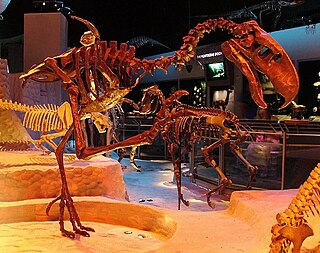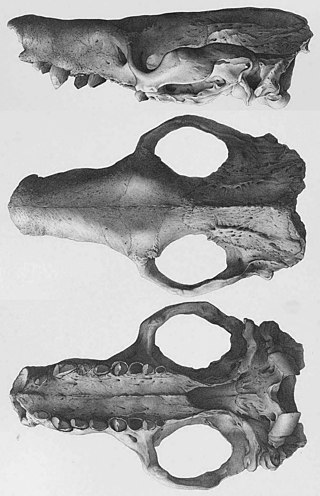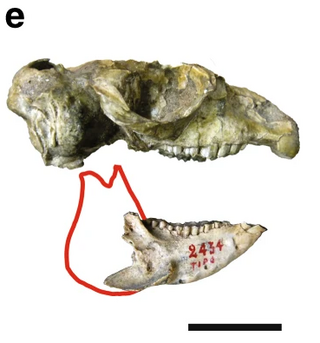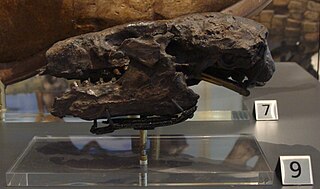
Phorusrhacids, colloquially known as terror birds, are an extinct family of large carnivorous, mostly flightless birds that were among the largest apex predators in South America during the Cenozoic era. Their definitive fossil records range from the Middle Eocene to the Late Pleistocene around 43 to 0.1 million years ago, though some specimens suggest that they were present since the Early Eocene.
Cyonasua is an extinct genus of procyonid from the Late Miocene to Middle Pleistocene of South America. Fossils of Cyonasua have been found in Argentina, Bolivia, Uruguay, and Venezuela. The oldest well-dated fossils of Cyonasua are approximately 7.3 million years old. Most fossils of Cyonasua are late Miocene to early late Pliocene in age, but a single early Pleistocene specimen indicates that members of this genus survived until at least 0.99 million years ago.

Procariama is an extinct monotypic genus of phorusrhacid, which lived from the Late Miocene to the Late Pliocene of Argentina. Fossils of the animal have been found in six places, in the Cerro Azul and Andalhuala Formations. More specifically in the Andagalá department and in the north of the Belén department of the Catamarca province, with a single location in the La Pampa province. The type and only species, Procariama simplex, is the largest member of the subfamily Psilopterinae.
The Huayquerian age is a period of geologic time within the Late Miocene epoch of the Neogene, used more specifically within the SALMA classification. It follows the Chasicoan and precedes the Montehermosan age.

Neuquén Basin is a sedimentary basin covering most of Neuquén Province in Argentina. The basin originated in the Jurassic and developed through alternating continental and marine conditions well into the Tertiary. The basin bounds to the west with the Andean Volcanic Belt, to the southeast with the North Patagonian Massif and to the northeast with the San Rafael Block and to the east with the Sierra Pintada System. The basin covers an area of approximately 120,000 square kilometres (46,000 sq mi). One age of the SALMA classification, the Colloncuran, is defined in the basin, based on the Collón Curá Formation, named after the Collón Curá River, a tributary of the Limay River.

Eleutherocercus was a genus of glyptodonts that lived during the Late Miocene and Early Pliocene in South America. Fossils of the genus have been found in the Huayquerian Ituzaingó Formation and the Montehermosan Monte Hermoso Formation in Argentina.

Macroeuphractus is a genus of extinct armadillos from the Late Miocene to Late Pliocene of South America. The genus is noted for its large size, with Macroeuphractus outesi being the largest non-pampathere or glyptodont armadillo discovered, as well as its specializations for carnivory, unique among all xenarthrans.

Neolicaphrium is an extinct genus of ungulate mammal belonging to the extinct order Litopterna. This animal lived from the Late Pliocene (Chapadmalalan) to the Late Pleistocene (Lujanian) in southern South America, being the last survivor of the family Proterotheriidae.
The Cañadón Asfalto Basin is an irregularly shaped sedimentary basin located in north-central Patagonia, Argentina. The basin stretches from and partly covers the North Patagonian Massif in the north, a high forming the boundary of the basin with the Neuquén Basin in the northwest, to the Cotricó High in the south, separating the basin from the Golfo San Jorge Basin. It is located in the southern part of Río Negro Province and northern part of Chubut Province. The eastern boundary of the basin is the North Patagonian Massif separating it from the offshore Valdés Basin and it is bound in the west by the Patagonian Andes, separating it from the small Ñirihuau Basin.
The Colorado Basin is a sedimentary basin located in northeastern Patagonia. The basin stretches across an area of approximately 180,000 square kilometres (69,000 sq mi), of which 37,000 square kilometres (14,000 sq mi) onshore in the southern Buenos Aires Province and the easternmost Río Negro Province extending offshore in the South Atlantic Ocean.

The Cerro Azul Formation, also described as Epecuén Formation, is a geological formation of Late Miocene age in the Colorado Basin of the Buenos Aires and La Pampa Provinces in northeastern Argentina.
Typotheriopsis is an extinct genus of Notoungulate, belonging to the family Mesotheriidae, which included several small sized Meridiungulates specialized in digging. It is considered as the sister taxon of the clade including Mesotherium and Pseudotypotherium. Its fossils are known from the Chasicoan and the Huayquerian periods, notably among Late Miocene rocks from the Arroyo Chasicó Formation and the Cerro Azul Formation of Argentina.

Paedotherium is an extinct, potentially paraphyletic genus of Notoungulate, belonging to the family Hegetotheriidae, composed of small-sized, rodent or lagomorph-like South American ungulates. Four species are unambiguously recognized, from the Late Miocene to the Pleistocene of Argentina, and from the late Miocene of Bolivia and Chile.
Promacrauchenia is an extinct genus of macraucheniids that lived during the Late Miocene to Late Pliocene epochs of what is now Argentina and Bolivia. It belongs to the subfamily Macraucheniinae, which also includes Huayqueriana, Macrauchenia, and Xenorhinotherium. Fossils of this genus have been found in the Ituzaingó, Andalhuala, and Cerro Azul Formations of Argentina.

Tremacyllus is an extinct genus of hegetotheriids. It lived from the Late Miocene to the Late Pleistocene and its fossilized remains were discovered in South America.
Proadinotherium is an extinct genus of toxodontid. It lived between the Late Oligocene and the Early Miocene in what is now South America.

Proscelidodon is an extinct genus of ground sloths in the family Scelidotheriidae. It lived during the Miocene and Pliocene of what is now Argentina and Bolivia. The genus was described in 1935.
Mcdonaldocnus is an extinct genus of nothrotheriid ground sloths that lived during the Middle Miocene and Early Pliocene of what is now Bolivia and Argentina. It was originally placed in the genus Xyophorus but was subsequently recognized as a distinct genus by Gaudin and colleagues in 2022. The authors reassigned the material of "Xyophorus" bondesioi, Xyophorusvillarroeli and Xyophorus sp. to Mcdonaldocnus. Fossils of Mcdonaldocnus have been found in the Cerro Azul Formation of Argentina.
The Chichinales Formation is a geological formation in Río Negro Province, Argentina which dates from the Late Oligocene to the Early Miocene, around 23 to 17.5 million years ago. It predominantly consists of pyroclastic deposits, which were deposited in a semi-arid environment. It is divided up into a number of members. The diverse fauna of the Chichinales Formation, including a variety of turtles and birds, also includes many mammals such as South American native ungulates as well as armadillos, and caviomorph rodents.

Perimys is an extinct genus of neoepiblemid rodent that lived from the Early to Late Miocene in what is now South America. Fossils have been found in the Cerro Bandera, Cerro Boleadoras, Ituzaingó, Santa Cruz, and Sarmiento Formations of Argentina, and the Galera, Santa Cruz and Río Frías Formations of Chile.



















